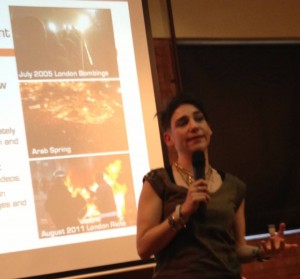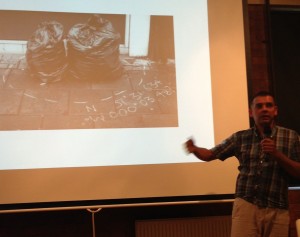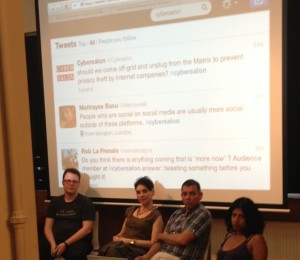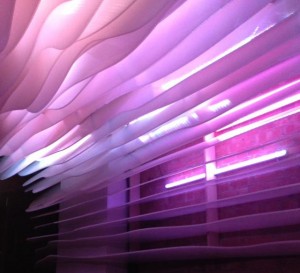
Summary: Mobile Cultures from London Yuppies to #TaksimSquare
26 June 2013 – 20 Years of Mobiles
Write-up by Eva Pascoe
It was a warm and muggy London afternoon, with a slimy sprinkling of pollution and a fair amount of intense pollen flying around and making our eyes water and throats dry. It felt like Singapore when Indonesian forest fires blow North, engulfing the city in a cloud of sweet-smelling smoke from the palm plantations.
I was rushing to Arts Catalyst for our final Cybersalon before the summer break, and casting wistful glances at a nearby park , where all the sensible people were spread out on the blankets with their cold beers in the buckets. Not me, duty calls and with pizza under one hand and a bunch of halogens in another, we made our way to Shoreditch.
The evening started slow, with a trickle of guests coming, looking hot and bothered. We assessed the situation as 9 out of 10 on the emergency ranking and dug deep into the fridge to get them the coldest of beers. It worked. After about 30 minutes the audience perked up and the grey matter started firing up on all neurons. And we needed the guests to be sharp as the topic of the Cybersalon was a loaded one – Mobile Cultures 1993-2013, from London Yuppies to #TaksimSquare.
First we had the intro from Niki Gomez, who is one of the authors of the Mobile Manifesto (Cybersalon 2000) and co-founders of Cybersalon. Sporting an extremely elegant purple (yes, it’s the new black!) ankle-length dress, Niki took us on a memory trip back to one of the early Cybersalons, when Jaron Lanier had just hit the scene with his Internet-Dystopia-on-tour attitude and destroyed Cybersalon’s Sony Aibo dog on stage during one of his anti-tech rants. Watching the video of it was quite entertaining in itself, but the point Niki was making, was that led by her, Cybersalon had developed a pre-Twitter wall device that we called CyberTalk. It was an audience participation tool and allowed the guests to SMS a screen during the event, comment on speakers like Jaron and their rants and take a view on the mistreatment of the poor Aibo dog.
Jaron Lanier VS The Audience – at Cybersalon, London 2001
CyberTalk was actually quite a smooth process, the audience loved being part of the conversation via SMS on the large screen. I am still puzzled why we did not develop it commercially then as it was immensely successful during the subsequent Cybersalons. Maybe I was too busy coping with the post-dot-com-crash picking ourselves up from the post-investment floor, the London scene full of start-up blood and corpses of various Internet tragedies like Boo, that had all crashed about that time.. You can read The Guardian article (from 2001) on CyberTalk here.
Niki also showed the Cybersalon Mobile Manifesto from 2000 and picked up on how some of the ideas in it have survived the test of time. Much scaremongering amongst the so-called futurologists in the 90’s was about Haves-and-Have-nots, expecting some super-rich tech-elite to take the world over and the poor becoming the casualty of tech-progress. The mobiles initially were only accessible to the very wealthy stock-brokers, currency traders and finance professionals (Yuppies). Nobody expected then, that mobiles would turn into micro-uber computers, and also that the price of the mobile computing would become so low as to be available to practically anyone who wants to use it. We still have tech-elites sure, but mobiles are certainly democratising access.
Sophia Drakopoulou, our very own Cybersalonista who completed a PhD on the topic of Mobile Cultures, took us through the early history of mobile phone activism – from WTO 1999, Philippines 2001, Madrid 2004 after the terrorist train tragedy, up to the more recent Arab Spring, covered in detail by Paolo Gerbaudo in “The Tweets and the Streets”.

Sophia noted that we should avoid jumping to techno-deterministic conclusions that technology led to those movements. She comments that the movements of resistance were augmented by technology, contributing to the intensity and concentration of resources. Sophia also noted the key characteristics of a phase we are currently going through, where Urban Spaces (atoms) are getting increasingly mixed with Virtual Spaces (bits). We are sharing our Now: by sending things like photos, we are capturing and savouring the moment. Mobile culture is of a very social nature and is focused on the intense experience of the present and the sharing of the moment with our significant others. It was noted there there is an extreme Time-Proximity of taking the photo and sharing it quickly, which is different to the pre-Social Media manners of using photos for wider social purposes. One of her comments particularly struck a chord with me – according to Sophia, if someone responds fast to your Txt or Tweet, it indicates a high degree of intimacy.
She noted that the physical and virtual is meshing, developing new rules of engagement. Perhaps some of those rules are subconscious, but as any society, even the virtual-physical will get organised alongside some lines, we just don’t know as yet what they will be. So new rules of social media engagement are emerging and a new netiquette is being forged, those allowing us to maintain the intimate links without drowning in the see of the ‘river of Twitter or FB news’.
In such User-Generated Content (UGC) the cameraphone images are often poor quality, grainy and smudgy, adding to their authentic character.
Her presentation also touched on UGC received by the BBC for:
July 2005 London Bombings – 1000 photos sent by the public
Feb 2009 the snow in London – 24,000 images, and
Dec 2010 Christmas snow in London reached 35,000 images.
Beyond this, recent data in UK shows that we take 1.9 bn images in just a month! Less than 10 % of those ever get printed or become physical objects. There is a danger that the lack of proper archiving will lead to a massive gap in records and with the progress of technology platforms, most of those images will become inaccessible. This is not a problem for the suppliers of Cloud and Photo Stream as they are not responsible for future-proofing your images, this is a problem for us as individuals!
Sophia also looked at contribution of Blast Theory (2002-2004), Urban Tapestries (2004) and Node London Festival (2006) that explored the power of Locative Media, experimenting with early GPS and various aspects of physical presence on electronic maps, each addressing a subtle and sensitive re-negociation of the impact of the knowledge where things/people/events are in real-time.
Watch this space as Sophia is working on a new paper, commenting on the latest developments.
A Moment of Experimentation: Spatial Practice and Representation of Space as Narrative Elements in Location-based Games (a past work by Sophia).
Pete Gomes then explained his fascinations with Making the Invisible Visible.

It all started with walking around London to find Wi-Fi spots (in 2001 he found only four!) and noting them on a map as a resource for the other artists. He was exploring the power of mapping knowledge, making Chalk Marks on the pavements as sign for others that Wi-Fi is HERE! That grew to be a shared knowledge, very useful in the early days of Wi-Fi. Working outside of your office on a laptop on a bench was extremely radical at that time (2002) and people who did that, found a shared notion of belonging to a ‘Wi-Fi’ nomad tribe. A tribe that we all have quickly joined ourselves! Also, it pushed him to investigate the impact of mapping the Nautical GPS coordinates, and locating bin bags with their exact geo-Loc. “Mappiness is happiness” at it emerged that all the Geo-knowledge was extremely enjoyable for the participants and produced great new mobile experiences!

Although at the time the Chalk Marks Project was an art piece, today the concept of embedding a location signal in bin bags could be easily applied to improve the efficiency of rubbish collection (Smart Cities).
We speculate that the Geo-Location information of moving objects in real-time can be a highly powerful tool in the Urban Protest movement, increasing the efficiency of the choreography of crowds – from walkie-talkies to Location Based Check-ins. Mapping allows the protesters to have the same knowledge as the Police during the protests, therefore levelling the playing field for the first time since the Urban Protests emerged.

Our final speaker, Christian Nold is a pioneer of early Self-Tracking. He has applied instruments like the Lie Detector to track the physiological changes during a walk around town, and notifies changes over the mobile, creating a map of emotional states of his neighbourhood. The sensors that enabled the ‘quantified-self’ were used while sober, drunk, having an argument and having just a normal set of activities in the usual places, his ‘local’, the shops and mapping it all to produce a ‘Sentiment Map’.
This map indicated that we are extremely sensitive to the environment, and even a fairly innocuous pedestrian crossing caused a significant hike in the heart rate and pulses of the participants. He then tracked others in a similar vein, observing that some places spiked more anxiety than others, for examples shops (where an ‘Argument with Mum’ took place, was mentioned often) and when street planning was bad. It could be useful to gather today’s quantified-movement tribe data and collate it for some key locations, to help city planners and developers of the Smart Cities movement. Today Christian is engaged in Extreme Citizen Science work, where these techniques are used to help and resolve issues around new runway planning (at Heathrow Airport). Our audience was very intrigued in the civic applications of collated self-tracking and Cybersalon will return to the topic in November for a Smart Cities event in the autumn.
Christian also mentioned the early camera that he developed for his self-tracking escapades in 2002, one that took photos every 30 seconds and documented the journey of his research. A very similar life-logging camera has now been successfully funded, called Memoto.com, that utilises cloud storage for the immense amount of photos generated. He commented that the cloud enabled those old ideas to be viable through resolving the photo storage issues, and that there is a great amount to be uncovered from the early self-tracking and Locative Media experiments. He pointed out how technologies developed by academia are being repackaged and repurposed by entrepreneurs- from Steve Mann and his wearable computer at MIT to Memoto today.
See more on Christian’s work at biomapping.net.

We finished the evening with a very intense debate about the future of Mobile Cultures. One priority was to consider whether mobile culture is Borg like. Is it swallowing the Internet, and what are the implications/regulations as the move from PCs to mobile computing has massive implications on retail, education, health and work practices?
Also, the issue of a contagious addition to mobile phones was raised by Rob Le Frenais (our Arts Catalyst host). Research that we look at our phones about 150 times per day on the average, was quoted, and many of us do so much more often. In fact, some of us admitted to not looking much at anything else! The discussion moved to finding tools to be more mindful, and examine if technology can help to increase mindfulness and concentration.
If you’re interested in this area, seek Wisdom 2.0, a Mindfulness Conference in Silicon Valley.
Richard Boase (who we met through a shared interest in Bitcoin) responded that technology makes mindfulness impossible and we need to seek solutions by limiting the time on the device rather than yet more technology to augment mindfulness. The audience agreed that liberating our minds and attention from the additive mobile devices is a priority. Richard also talked about the idea that the Internet is writing our biographies using all our public data, but we need to intervene to author our own autobiographies.

At this point we moved to a very physical pub next door, where a very beautiful, eerie installation of halogen lights and half-shades completed the intense mood of the evening. The ongoing discussions in the pub were massively helped by the heap of mobiles placed strategically on the centre of the wooden table, to ensure the full, uninterrupted and intense engagement with a pint of a cool lager. Despite the muggy day, the evening turned out to be a highly stimulating gathering which left us with more questions than it answered, but that is how we like it!
(Additional edits by Niki Gomez and Sophia Drakopolou).
